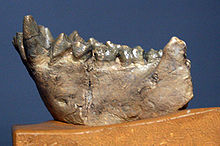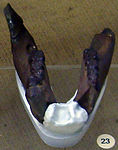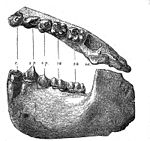- Dryopithecus
-
Dryopithecus
Temporal range: 12–9 Ma miocene
mandible fragment of Dryopithecus fontani from Saint-Gaudens, France (Middle Miocene, 11,5 My) ; cast from Museum national d'histoire naturelle, Paris Scientific classification Kingdom: Animalia Phylum: Chordata Class: Mammalia Order: Primates Superfamily: Hominoidea Family: Dryopithecidae† Genus: Dryopithecus†
Lartet, 1856Species - †Dryopithecus wuduensis
- †Dryopithecus fontani
- †Dryopithecus brancoi
- †Dryopithecus laietanus
- †Dryopithecus crusafonti
Dryopithecus was a genus of apes that is known from Eastern Africa into Eurasia during the late Miocene period. The first species of Dryopithecus was discovered at the site of Saint-Gaudens, Haute-Garonne, France, in 1856.[1] Other dryopithecids have been found in Hungary,[2] Spain,[3] and China.[4]
Like Sivapithecus, Dryopithecus was suspensory, had a large brain, and a delayed development, but, unlike the former, it had a gracile jaw with thinly enameled molars and suspensory forelimbs; Begun 2004 notes that the similarities and differences between them provides insight into the timing and paleogeography of hominid origins and the phylogenetic divide between Asian and Afro-European great apes. [5]
Contents
Description
Dryopithecus was about 60 centimetres (24 in) in body length, and more closely resembled a monkey than a modern ape. The structure of its limbs and wrists show that it walked in a similar way to modern chimpanzees, but that it used the flat of its hands, like a monkey, rather than knuckle-walking, like modern apes.[6] Its face exhibited klinorhynchy, with its face being tilted downwards in profile.
It likely spent most of its life in trees, and was probably a brachiator, similar to modern orangutans and gibbons. Its molars had relatively little enamel, suggesting that it ate soft leaves and fruit, an ideal food for a tree-dwelling animal.[6]
The five-cusp and juvenile[7] fissure pattern of its molar teeth, known as the Y-5 arrangement, is typical of the dryopithecids and of hominoids in general.
Additional images
Dryopithecus fontani jaw in front view at the Geological Museum, CopenhagenJaw of Dryopithecus fontani
The Dryopithecus tooth pattern shows up most clearly in mandibular first molars of humans.Notes
- ^ Pilbeam & Simons 1971
- ^ Kordos & Begun 2001
- ^ Harrison, Ribot & Gibert 1996
- ^ Xue & Delson 1989
- ^ Begun 2004, Abstract, Conclusions
- ^ a b Palmer 1999
- ^ Simons 1983
References
- Begun, David R. (2004). "Sivapithecus is east and Dryopithecus is west, and never the twain shall meet". Anthropological Science 113 (1): 53–64. doi:10.1537/ase.04S008. http://citeseerx.ist.psu.edu/viewdoc/download?doi=10.1.1.88.1617&rep=rep1&type=pdf.
- Harrison, Terry; Ribot, F; Gibert, J (1996). "A reinterpretation of the taxonomy of Dryopithecus from Valles-Penedes, Catalonia (Spain)". Journal of Human Evolution (31): 129–141. http://www.nyu.edu/gsas/dept/anthro/programs/csho/Content/Facultycvandinfo/Harrison/1996_Harrison_Niah.pdf. Terry Harrison's faculty page
- Kordos, László; Begun, David R. (2001). "A new cranium of Dryopithecus from Rudabánya, Hungary". Journal of Human Evolution 41 (41): 689–700. doi:10.1006/jhev.2001.0523. http://anthropology.utoronto.ca/Faculty/Begun/rud200.pdf.
- Palmer, D, ed (1999). The Marshall Illustrated Encyclopedia of Dinosaurs and Prehistoric Animals. London: Marshall Editions. p. 292. ISBN 1-84028-152-9.
- Pilbeam, David; Simons, E. L. (February 1971). "Biological Sciences: Humerus of Dryopithecus from Saint Gaudens, France". Nature 229 (229): 406–407. doi:10.1038/229406a0. PMID 4926991.
- Simons, E. L.; Meinel, W. (1983). "Mandibular ontogeny in the miocene great apeDryopithecus". International Journal of Primatology 4 (4): 331–162. doi:10.1007/BF02735598.
- Xue, Xiang-Xu; Delson, Eric (1989). "A new species of Dryopithecus from Gansu, China". Chinese Science Bulletin (34): 223–230. http://pages.nycep.org/ed/download/pdf/Xiang-Xu_and_Delson_1987.pdf.
External links
Categories:- Prehistoric apes
- Miocene mammals
- Fossil taxa described in 1856
Wikimedia Foundation. 2010.


